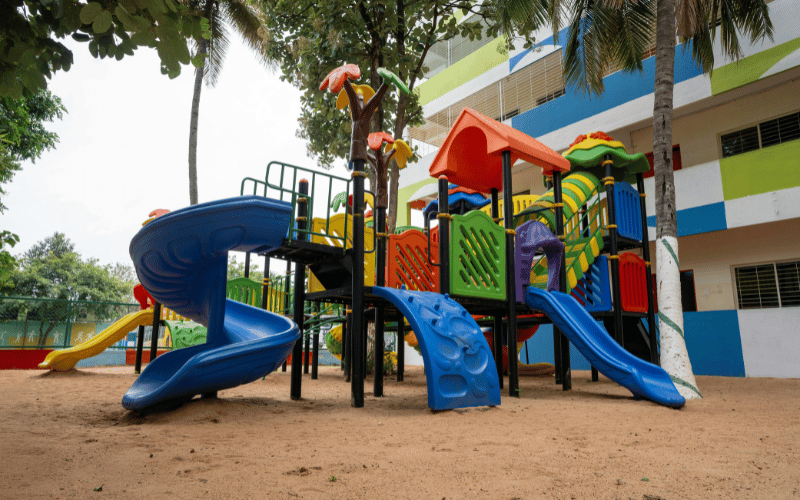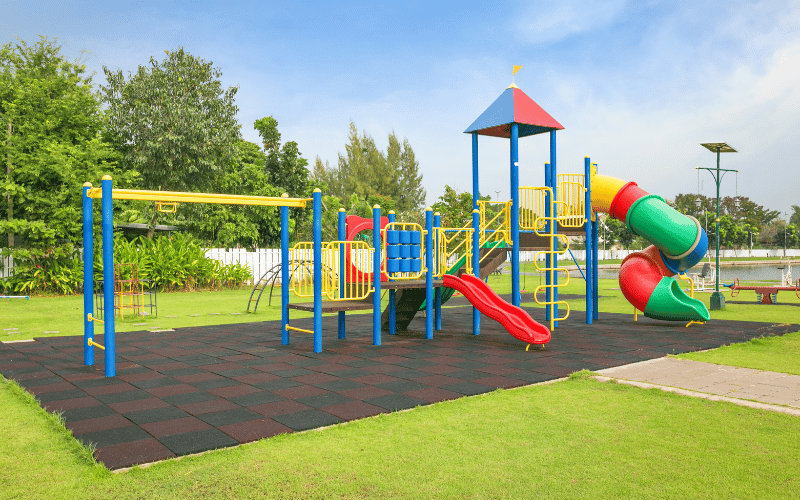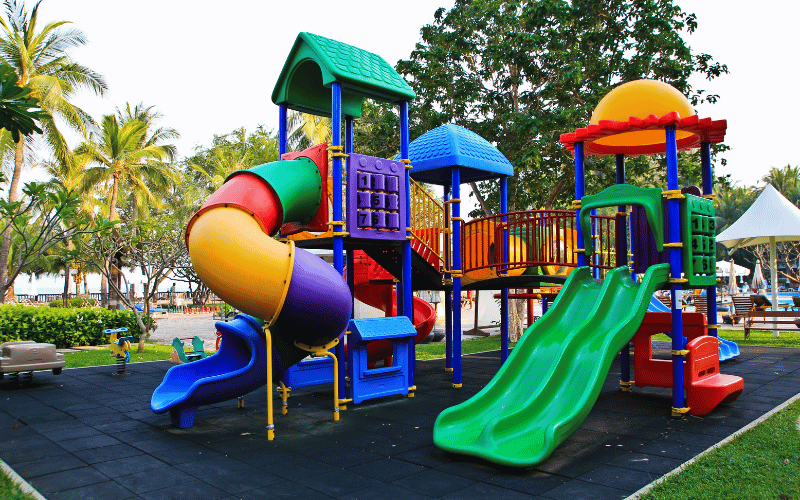The materials used in playgrounds play a critical role in ensuring children’s safety, enjoyment, and inclusivity. Parents, caregivers, and facility managers all want play areas that are not only fun but also durable and safe for kids of all ages. Choosing the right material impacts everything from the longevity of the equipment to the level of accessibility for children with different needs.
Over the years, playgrounds have evolved significantly. Wood and metal, once the dominant materials, have gradually given way to plastic. This shift didn’t happen by accident. Wood, while natural, often splinters and requires constant maintenance to prevent rot. Metal, though sturdy, heats up dangerously in the sun and can rust over time. Plastic, on the other hand, has emerged as the material of choice for modern playgrounds due to its versatility, safety, and durability.
This article explores why plastic has become the go-to material for playgrounds. From its ability to withstand harsh weather to its design flexibility and safety features, plastic offers a range of benefits that make it ideal for today’s play areas. Whether you’re a parent, a school administrator, or a community planner, understanding these advantages will help you make informed decisions about playground materials. Let’s dive into why plastic is redefining the way we think about playgrounds.
Table of Contents
ToggleThe Top Benefits of Plastic Playground Equipment
Plastic playground equipment has revolutionized the way we think about play areas, offering a combination of safety, durability, and versatility that other materials simply can’t match. Let’s break down the key benefits of plastic and why it has become the gold standard for modern playgrounds.
Safety First
When it comes to playgrounds, safety is non-negotiable. Plastic excels in creating a safer environment for children, addressing many of the risks associated with older materials like wood and metal.
- Smooth Surfaces Eliminate Splinters and Sharp Edges: Unlike wood, which can splinter over time, or metal, which often has sharp corners, plastic provides smooth, rounded surfaces that reduce the risk of cuts and scrapes. For example, plastic slides and climbing structures are designed with child-friendly edges that prioritize safety.
- Plastic Stays Cooler Than Metal in the Sun: On a hot summer day, metal equipment can become dangerously hot, causing burns. Plastic, however, retains a much cooler surface temperature, making it safer for children to play on even during peak sunlight hours.
- Rounded Edges and Impact-Absorbing Designs Minimize Injuries: Many plastic components are molded with rounded edges and built-in shock-absorbing features, such as flexible panels or cushioned surfaces, to reduce the impact of falls.
Durability and Weather Resistance
Playground equipment must endure constant use and exposure to the elements. Plastic rises to the challenge, offering unmatched durability and weather resistance.
- Plastic Resists Rust, Rot, and Warping: Unlike wood, which can rot or warp, and metal, which is prone to rust, plastic remains unaffected by moisture and temperature changes. This makes it ideal for outdoor environments where weather conditions can be unpredictable.
- Withstands Extreme Weather Conditions: Whether it’s scorching heat, freezing temperatures, or heavy rain, plastic holds up without cracking, warping, or degrading. For instance, plastic climbing walls and slides maintain their structural integrity even after years of exposure to harsh climates.
- UV-Stabilized Plastic Prevents Fading and Degradation: High-quality plastic playground equipment is treated with UV stabilizers, ensuring that vibrant colors stay bright and the material doesn’t weaken under prolonged sun exposure.
Low Maintenance
Plastic playground equipment not only lasts longer but also requires far less upkeep, saving time and money in the long run.
- Easy to Clean with Soap and Water: A quick wipe-down with soapy water is all it takes to keep plastic equipment looking fresh and clean. This simplicity makes it easy for schools, parks, and community centers to maintain their playgrounds.
- Resistant to Graffiti and Vandalism: Plastic surfaces are less porous than wood or metal, making them harder for graffiti to stick to and easier to clean if vandalized.
- No Need for Repainting, Sealing, or Frequent Repairs: Unlike wood, which requires regular sealing, or metal, which needs repainting to prevent rust, plastic remains low-maintenance throughout its lifespan.
Design Versatility
Plastic’s flexibility in design allows for creative and engaging playgrounds that spark children’s imaginations.
- Vibrant Colors and Creative Shapes Enhance Imaginative Play: Plastic can be molded into a variety of shapes and painted in bright, eye-catching colors. For example, you can find playgrounds with pirate ships, castles, or jungle themes, all made possible by the versatility of plastic.
- Customizable Designs Allow for Themed Playgrounds and Unique Features: Whether you’re designing a playground for a school, park, or community space, plastic offers endless customization options to create a unique and memorable play area.
Inclusivity and Accessibility
Modern playgrounds should be spaces where all children, regardless of ability, can play together. Plastic makes this inclusivity possible.
- Plastic Enables the Creation of Wheelchair Ramps, Transfer Platforms, and Ground-Level Play Areas: Unlike traditional materials, plastic can be easily molded into accessible features that promote inclusive play. For example, ramps and transfer platforms allow children with mobility challenges to access elevated play structures.
- Promotes Inclusive Play for Children of All Abilities: Ground-level play panels, sensory features, and interactive elements made from plastic ensure that every child can participate in the fun, fostering a sense of community and belonging.
Plastic playground equipment combines safety, durability, and creativity to create play spaces that are not only fun but also built to last. By choosing plastic, you invest in a material that meets the needs of children, parents, and communities alike, ensuring that playgrounds remain safe, engaging, and inclusive for years to come.

Comparing Plastic to Other Materials
When choosing materials for playground equipment, it’s essential to weigh the pros and cons of each option. Plastic, wood, metal, and composite materials all have their place, but plastic consistently stands out for its safety, durability, and versatility. Let’s break down how plastic compares to these alternatives.
Plastic vs. Wood
Wood may evoke a sense of nostalgia, but it falls short when it comes to long-term safety and maintenance.
- No Risk of Splinters or Rot: Wood, especially untreated or poorly maintained varieties, can splinter over time, posing a risk of cuts and injuries. Plastic eliminates this concern with its smooth, splinter-free surfaces. Additionally, wood is prone to rot when exposed to moisture, while plastic remains unaffected by rain or humidity.
- Requires Less Maintenance and Lasts Longer: Wooden playgrounds demand regular sealing, staining, and repairs to prevent decay and maintain their appearance. Plastic, on the other hand, requires minimal upkeep—just occasional cleaning with soap and water. Its durability ensures it lasts for years without the need for constant attention.
Plastic vs. Metal
Metal playground equipment, while sturdy, presents its own set of challenges that plastic overcomes with ease.
- Stays Cooler in the Sun and Resists Rust: On a hot summer day, metal equipment can become dangerously hot, making it unsafe for children to touch. Plastic stays significantly cooler, even under direct sunlight, ensuring a safer play experience. Additionally, metal is susceptible to rust, especially in humid or coastal environments, whereas plastic resists corrosion entirely.
- Safer for Children Due to Its Softer, Impact-Absorbing Properties: Metal’s rigid structure can lead to more severe injuries during falls. Plastic, with its softer and more flexible properties, absorbs impact better, reducing the risk of serious harm. For example, plastic slides and panels are designed to cushion minor bumps and falls, making them a safer choice for active play.
Plastic vs. Composite Materials
Composite materials, often a blend of wood fibers and plastic, aim to combine the best of both worlds but come with their own limitations.
- More Cost-Effective: While composite materials can be durable, they are often more expensive to produce and install than pure plastic. Plastic offers a more budget-friendly option without compromising on quality or longevity.
- Easier to Customize: Composite materials are limited in terms of design flexibility. Plastic, however, can be molded into virtually any shape or color, allowing for creative and engaging playground designs. Whether you want a pirate ship, a jungle gym, or a space-themed play area, plastic makes it possible to bring those ideas to life.
By comparing plastic to wood, metal, and composite materials, it’s clear that plastic offers a unique combination of safety, durability, and design versatility. Its ability to address the shortcomings of other materials makes it the ideal choice for modern playgrounds, ensuring a safer and more enjoyable experience for children and peace of mind for parents and caregivers.
Sustainability and the Future of Plastic Playgrounds
Plastic playgrounds are not just about safety and durability—they are also evolving to meet the growing demand for sustainability and innovation. By embracing eco-friendly practices and forward-thinking designs, the industry is shaping a future where playgrounds are both environmentally responsible and engaging for children.
Eco-Friendly Innovations
Sustainability has become a driving force in playground manufacturing, and plastic is leading the charge with its ability to be recycled and repurposed.
- Use of Recycled Plastics in Manufacturing: Many manufacturers now use post-consumer and post-industrial recycled plastics to create playground components. For example, milk jugs, detergent bottles, and other plastic waste are transformed into durable slides, panels, and climbing structures. This not only reduces landfill waste but also lowers the carbon footprint of production.
- Fully Recyclable at the End of Its Lifecycle: Unlike wood or composite materials, plastic playground equipment can be fully recycled when it reaches the end of its use. Manufacturers often design components with this in mind, ensuring that old equipment can be broken down and repurposed into new products. This closed-loop system promotes sustainability and reduces environmental impact.
Future Trends
The playgrounds of tomorrow are being designed with adaptability and innovation in mind, ensuring they remain relevant and functional for years to come.
- Modular Designs for Easy Upgrades and Repairs: Modular playground systems are becoming increasingly popular, allowing individual components to be replaced or upgraded without dismantling the entire structure. For instance, if a slide becomes worn or outdated, it can be replaced with a new one without disrupting the rest of the playground. This approach extends the lifespan of the equipment and reduces waste.
- Integration of Smart Features: The future of playgrounds includes interactive panels, sensory play elements, and even technology-driven features like sound and light effects. For example, some playgrounds now include panels that light up or play music when touched, creating a multi-sensory experience that engages children in new and exciting ways. These features not only enhance play but also support cognitive and sensory development.
By focusing on sustainability and innovation, plastic playgrounds are paving the way for a greener, more adaptable future. The combination of eco-friendly materials and forward-thinking designs ensures that playgrounds will continue to inspire and delight children while respecting the planet.

Practical Tips for Choosing Plastic Playground Equipment
Selecting the right plastic playground equipment requires careful thought and attention to detail. By focusing on safety, durability, and community needs, you can ensure the equipment you choose will provide a safe and engaging play environment for years to come. Let’s explore the key considerations and the importance of working with trusted manufacturers.
Key Considerations
When evaluating plastic playground equipment, it’s essential to prioritize safety, longevity, and suitability for your specific audience.
- Look for Safety Certifications and Compliance with Standards: Always check that the equipment meets recognized safety standards, such as those set by ASTM International or the Consumer Product Safety Commission (CPSC). These certifications ensure that the equipment has been rigorously tested for hazards like entrapment, sharp edges, and structural stability. For example, compliant equipment will have rounded edges, proper spacing, and non-toxic materials.
- Choose UV-Stabilized Plastic for Long-Lasting Color and Durability: UV-stabilized plastic resists fading and degradation caused by prolonged sun exposure. This feature is essential for playgrounds in sunny climates, where intense UV rays can quickly wear down untreated materials. Look for equipment with warranties that guarantee UV protection to ensure vibrant colors and structural integrity over time.
- Opt for Designs That Match the Needs of Your Community or School: Consider the age range, abilities, and interests of the children who will use the playground. For example, younger children may benefit from low platforms and sensory panels, while older kids might prefer climbing walls and more challenging structures. Customizable designs allow you to create a playground that reflects the unique character of your community or school.
Working with Trusted Manufacturers
The quality of your playground equipment depends heavily on the manufacturer you choose. Partnering with a reliable supplier ensures you receive safe, durable, and well-designed products.
- Importance of Selecting Reliable Suppliers for Quality and Longevity: Trusted manufacturers prioritize safety and durability in their designs, using high-quality materials and advanced production techniques. They also provide warranties, installation support, and maintenance guidance, giving you peace of mind that your investment will stand the test of time. For example, a reputable supplier will offer detailed product specifications, safety certifications, and references from previous clients to demonstrate their commitment to excellence.
By focusing on safety certifications, UV protection, and tailored designs, and by working with trusted manufacturers, you can confidently choose plastic playground equipment that meets the needs of your community while ensuring long-term value and safety.
Frequently Asked Questions
Q: How does plastic compare to wood and metal in terms of durability?
A: Plastic outperforms wood and metal in durability. Unlike wood, plastic doesn’t rot, splinter, or warp when exposed to moisture. It also resists rust and corrosion, which are common issues with metal. High-quality plastic playground equipment can withstand years of heavy use and harsh weather without significant wear, making it a more reliable choice for long-term use.
Q: Is plastic playground equipment safe for all weather conditions?
A: Yes, plastic playground equipment is designed to handle a wide range of weather conditions. It resists cracking in freezing temperatures and doesn’t overheat like metal in direct sunlight. UV-stabilized plastic also prevents fading and degradation from prolonged sun exposure, ensuring safety and durability in any climate.
Q: Can plastic playground equipment be recycled?
A: Most plastic playground equipment can be recycled at the end of its lifecycle. Many manufacturers use recyclable materials in their designs and offer take-back programs to ensure old equipment gets repurposed. Choosing equipment made from recycled plastics also supports sustainability and reduces environmental impact.
Q: What features make plastic playgrounds more inclusive?
A: Plastic playgrounds often include features like wheelchair ramps, transfer platforms, and ground-level play panels, which promote accessibility for children with mobility challenges. Sensory play elements, such as textured panels or interactive features, engage children of all abilities, fostering inclusive play environments where everyone can participate.
Q: How long does plastic playground equipment typically last?
A: Plastic playground equipment typically lasts 15 to 20 years or more, depending on the quality of materials and maintenance. UV-stabilized plastic and durable construction ensure it withstands heavy use and environmental factors over time. Regular cleaning and inspections can further extend its lifespan, keeping it safe and functional for years to come.
Conclusion: Building Safer, Smarter Playgrounds with Plastic
Plastic playground equipment offers unmatched safety, durability, low maintenance, and sustainability, making it the ideal choice for modern play areas. By choosing plastic, you create a space that prioritizes children’s well-being while standing up to the demands of time and weather. Take the next step by considering plastic for your upcoming playground project. Consult experts or explore high-quality plastic playground options to design a safe, engaging, and inclusive play space that benefits your community for years to come.






